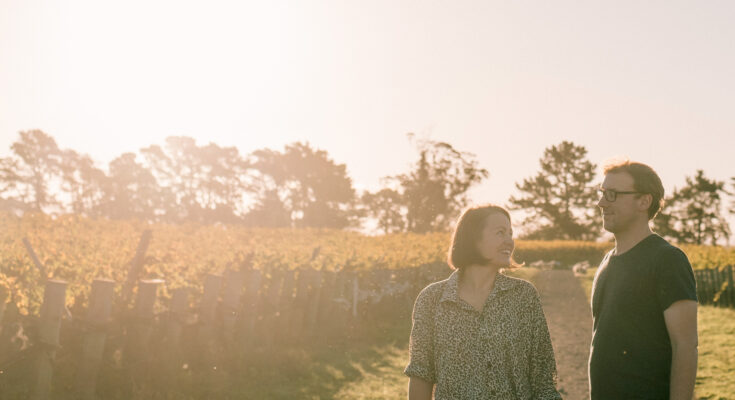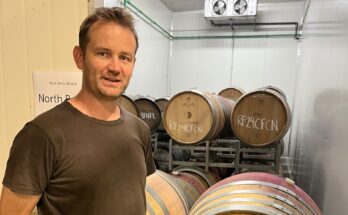Meeting up with Olly and Amy from Halcyon Days in the trendy part of Hastings at Cupple Café, I do start off with a little apprehension..
WineFolio: I’ve heard you guys are good, but can I say – I’ve never tried your wine. So I was a little worried when you suggested we meet in a café, and I turn up and have no context or background to go on, and we’d just discuss the ‘concept’ of your wine! So I’m pleased to see you do have samples!! Hahaha.
Amy: So, Halcyon Days is Olly and I. We met just over ten years ago in London. Olly was working for Decanter magazine. He came down to stay with me and we were making wine in Castilla y Leon in the northwest of Spain– big sky country – perfect weather, golden days, so much light. And that’s what we also think is amazing about Hawke’s Bay. There’s this amazing light, the perfect weather, the perfect climate. So Halcyon Days is like a nostalgic remembering of the golden weather – hence the reason we’re called Halcyon Days.
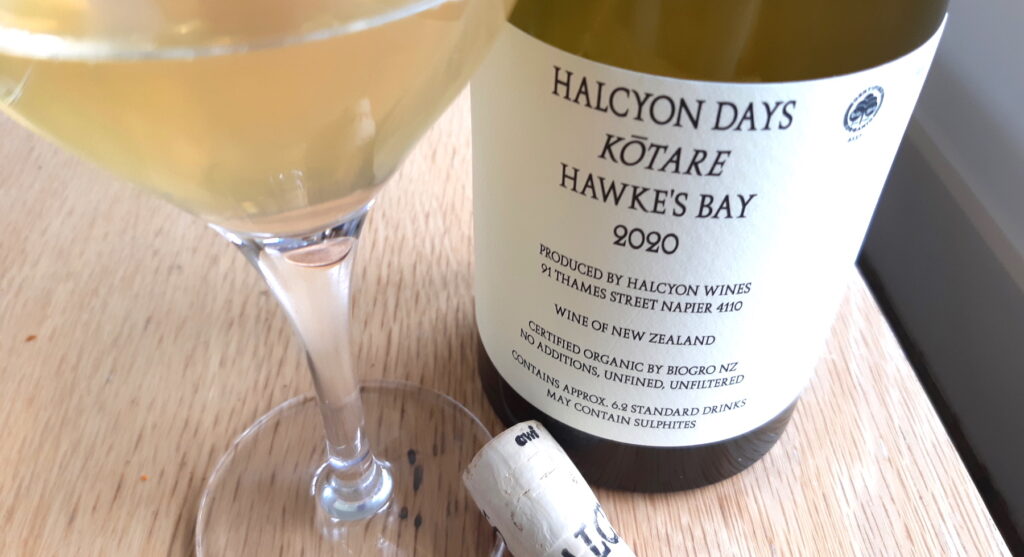
Amy: What you’re tasting is our ‘Kotare’ – that’s the sacred kingfisher, which is also part of the halcyon myth. We have a lot of them in this vineyard, in the Mangatahi sub-region. It’s on river terraces of the Ngaruroro river, so there’s a few kingfishers around. It’s about 70% Sauvignon Blanc which is all fermented on its skins with quite a lot of whole bunch. In ’19 we played around with the whole bunch and we really liked the texture and structure.
We did more whole bunch in ’20 than we did in ’19, and it gets a handful of Gewurz on its skins as well, because we love Gewurz but it can be overpowering. We did a very selective pick and we ended up with a couple of crates. We think that sub region is really well suited to aromatics. So beautiful Pinot Gris, Sauvignon, Gewurz. And actually we great Sangiovese from there!
WF: Wow, really? Because people are always after stuff like that – Nebbiolo, Sangiovese..
Olly: Yes, wish there was more, it’s so good.
Amy: And then the rest is remainder is Pinot Noir rose – just because we like the combination. And everything is off the same vineyard. There’s a lot of diversity in that vineyard – it’s awesome! We both love Sauvignon Blanc. It’s one of Olly’s main influences on the wine journey.
Olly: It’s kind of a hard sell in New Zealand, because as soon as you say ‘Sauvignon Blanc’ it comes with a whole bunch of preconceptions. When people say ‘what am I tasting?’ I usually just pour it for them and let them taste first.
Amy: Which is why we don’t normally have the varieties on the labels. Also, we love what the skins does to Sauvignon – flavour and texture wise. And it’s so different to what most people are expecting, that it’s better just not to have it on the label. Ironically, we have more freedom here to put things on the label than in France. Everything we do is BioGro certified and zero additions of any kind. This is only our third vintage and one of the reasons that we want to do our own thing is that we can really play around and push the boundaries.
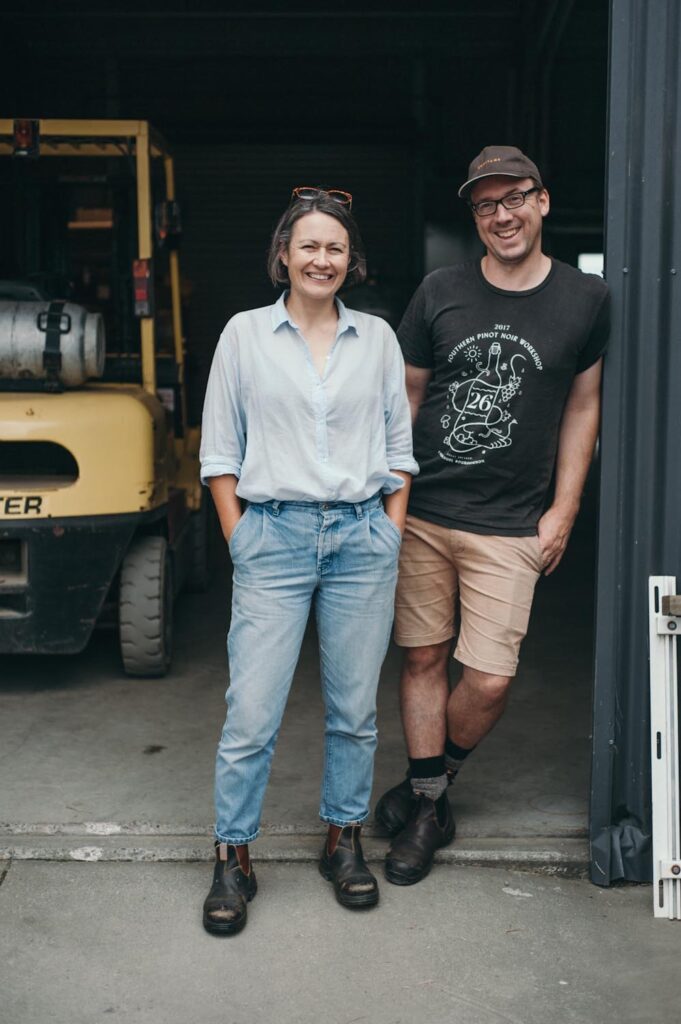
WF: so… who is this for?
Amy: Us! (laughing). People who are interested in wines that are focussed more on structure and texture. And that are interested in organics.
I think there’s no demographic that this appeals to. It’s anyone who’s interested in something a bit different. I showed this to my Uncle’s tasting group who are all at the verge of retiring, and did them a whole Natural Wine tasting. I was a little bit nervous at first, and they loved all of the wines, and all commented to me afterwards: “I so enjoyed that Kotare – my wine of the night!” And I’m like – that’s not what I expected. We shouldn’t have preconceptions based on background or age – it’s for anyone who is interested.
We’re involved with the vineyards but we don’t own them. ’19 was the first year we did Kotare, and it was much more austere, and I think that’s reflection of the vintage. 2020 was much drier and the fruit was more generous.
WF: It’s quite ethereal – wispy, and dances across the palate. I like it a lot.
Also, I wrote a bit recently about ‘Cult’ wines, and I think if I was showing someone this wine, that tastes like that – has those ingredients, and has a label like that.. they might think “cult wine”. Thoughts?
Olly: We could fit into that. We’d resist it.
WF: isn’t that even better – if you don’t want it? That makes you even more ‘cult’!! Accidentally cult?
Amy: ‘Cult wine’ just makes me think of Napa, and massive egos. Fingers crossed we don’t end up like that.
WF: Where can people get it retail and what would it sell for?
Amy: around $35, and it’s pretty much sold-out now. The small independent retailers, with personality, are good – we work with a lot of them. For retail in New Zealand, we’re with Everyday Wine, Point Chev Organics, Caro’s at Grey Lynn, Star Superette, and Bythebottle.co.nz.
WF: I’m really glad that people like Gregory Collinge at The Supernatural, and Hayden, have looked after me here – as I’m getting to spend time talking about wines that aren’t mainstream – we spent all of last evening on natural wines for example.
Amy: It’s a beautiful location too. Have you had the Gris Noir before? This is a skin-fermented Pinot Gris, which we love, and this vineyard has some really great Pinot Gris. In the past we’ve blended it with some Pinot Noir rose but this year we’ve played with syrah rose and that’s what is giving it the crazy colour. This doesn’t fit in a category that well – it could be orange, could be rose, it could even be a light red?
WF: So, I’ve had a bit of skin-fermented Pinot Gris before and I like it. The Valli one is amazing, and the Supernatural one is good too.
Amy: we’re very careful with our extraction, it gets a gentle hand plunge if it needs it, and other than that we just leave it alone. About two and a half weeks on skins. And it does have a tiny bit of Pinot Noir rose in it, because we love blending stuff!! Everything is aged in tank other than one experiment ageing in an old barrel, which may or may not work – we’ve got some of the Sauvignon ageing under flor at the moment. It aged quite oxidatively for a couple of months while we were trying to get the flor to grow. We likes wines under flor, so we wanted to try it.
WF: What’s that one with the young sherry that’s released?
Olly: En Rama? Wish we had more of that in New Zealand.
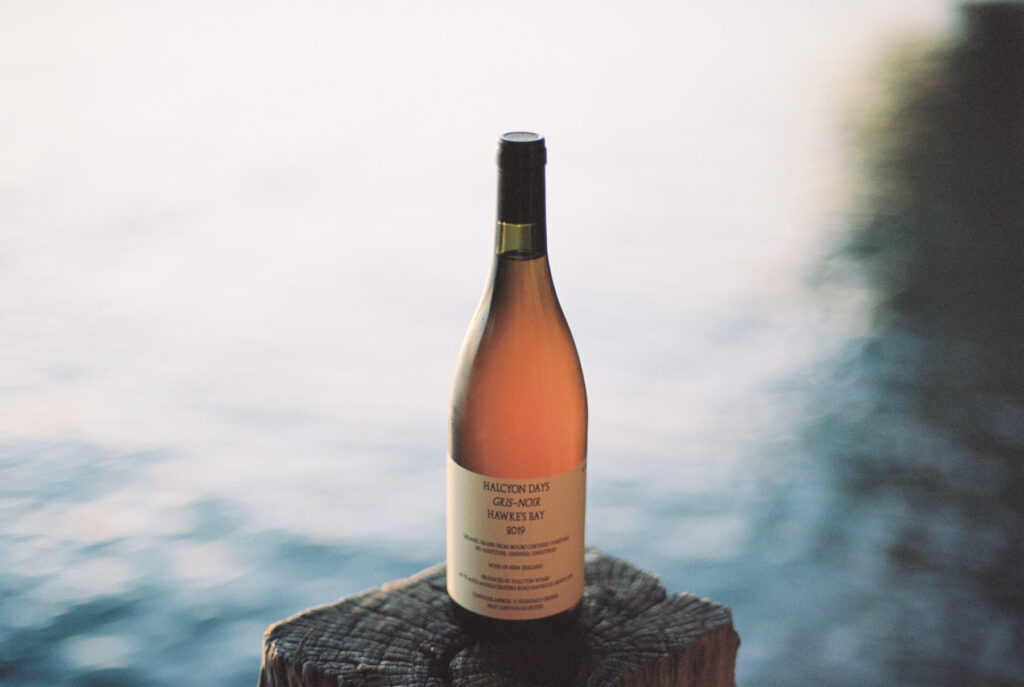
Amy: We were spoilt being in Spain, and it wasn’t a super popular category domestically in Spain, so we had access to whatever we wanted, at eye-wateringly affordable prices.
WF: You should do a Vermouth!
Amy: We are! Well, we have a friend who is working on a vermouth. We have an Italian friend, and we’ve given him the base wine – it will be a red one – and they’re going to do a foraged, organic vermouth.
WF: Do you do other things than just Halcyon Days? Do you do any work for other winemakers?
Amy: We have two small children. I make wine, bring in barrels, a bit with coffee as well, and some consulting.
Olly: I still write, as well as being a winemaker. I keep telling myself I’m going to do one vintage where it’s going to be Halcyon and nothing else, and then I get dragged into doing other stuff. I was at Riverview this year.
WF: That’s a great vineyard, I love it there.
Olly: It’s beautiful. So… maybe next year.
Amy: This is Luz, it’s a ‘joven’ style wine. 6 month-old wine, un-oaked, fresh, primary, bright – a whole bunch Syrah with a little bit of Pinot.
To be served chilled. We love this expression of Syrah as a vintage – 2020 – picked when it’s still super fresh. We didn’t want any shrivel. Careful to get very gentle extraction, and it still came out with quite a lot of colour. We were quite surprised when we pressed this. This is MS from the old block in Bridge Pa.
WF: If I was assuming that was a ‘lighter red’ it’s got plenty of body to go with that exquisite perfume.
Amy: It’s a shame they don’t export it much, because in Spain they drink a lot of ‘joven’ especially in the summer. You don’t really want a massive 15% Tempranillo on a 40 degree day. Luz is ‘light’, as in sunlight, in Spanish.
WF: Well you want the right wine in the right place. These would be great food wines as well? And, hang on – ‘may contain sulphites’??
Olly: We have to legally put that on.
Amy: We have the discussion every year whether we should, or not, put that on. And we’ve always erred on the side of caution. Just because it’s to do with allergies. The way they word it for the States is, I think, better. We haven’t added anything.
WF: And cork?
Olly: We love cork! It’s natural. We do have to weigh up what it costs to bring the cork here from Portugal, but then the screwcaps aren’t made here either. Cork seems to be the best natural option that we have. I’m really keen on Diam which is the reconstituted cork base, but the glue they use to put those together is synthetic.
Amy: But they do have a natural, organic one coming out. But it’s quite expensive. We’ve got friends trialling them. We like how wine ages under cork, and the rest is all environmental. From an environmental point of view there’s no perfect closure, so this is what works for us. We are always looking at our packaging through an environmental lens, as well as what’s best for the quality.
WF: And you do a Pet Nat?
Amy: We do normally but we didn’t in 2020. It’s the one thing we couldn’t do because of lockdown. We did a trial – which didn’t work (laughs). It got to exactly the correct sugar for bottling, the night we went to Level 4. And at that stage we hadn’t been notified whether we were ‘essential’ or not. In the scheme of things it didn’t seem like it was worth it, so. We’ve got what we think are going to be really interesting grapes for next year. Oh – no – we did do one Pet Nat that’s in a keg. So our friends over at Brave Brewery, we’ve always talked about putting some wines on the taps there. Regarding packaging we also really like keg – environmentally, and every glass is the same – really close the circle. They lent us two of their kegs and we finished the ferment in keg. So it is naturally sparkling in keg and then it aged for about 6 months on its lees – and they’ve just hooked it up. But it’s still quite cloudy and needs to settle for a couple of days. It’s got quite a different aromatic profile as well.
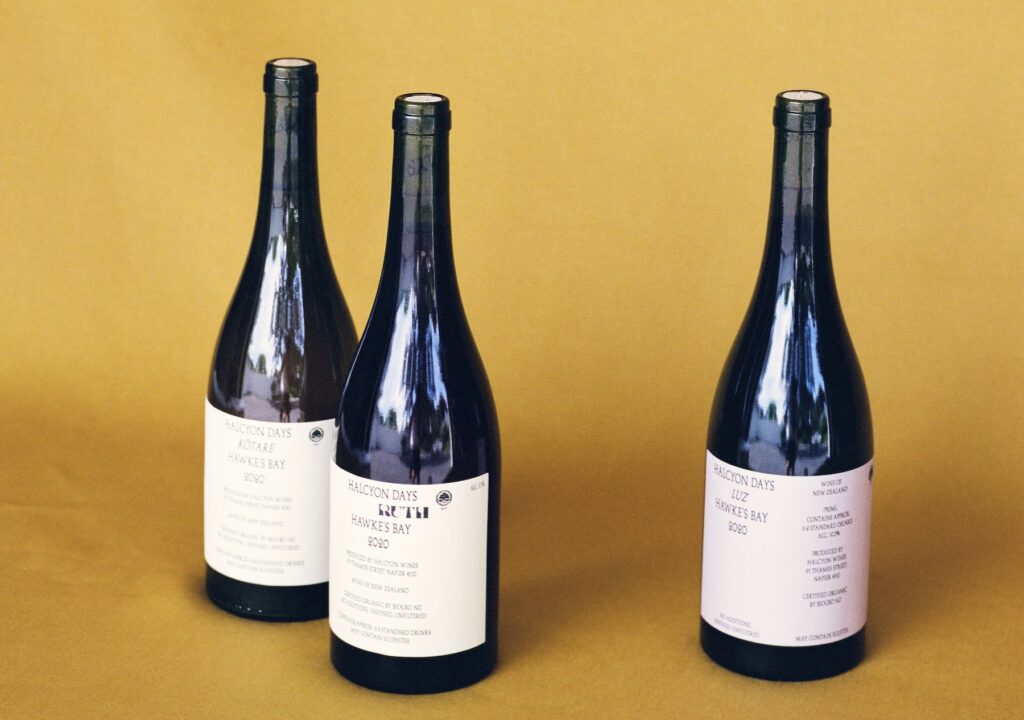
WF: Is there anything else in the pipeline?
Olly: Always, but also not trying too many things at once – rationalise it a bit. The Pinot Noir is a good example of that – you can’t justify to just blend it away if you do it. We really like it but, bizarrely it turns out with much more body than our whites. And a freshness as well.
Amy: We love it as a blending component – it’s pretty much in all our wines. Especially Mangatahi – that’s a great Pinot site.
WF: I’m here today but tomorrow I’m driving down south with Martinborough as my destination. Looking forward to some great Pinot Noir.
Amy: We both love Martinborough. That was our other choice when we were deciding where to settle.
One of the things that’s challenging here in Hawke’s Bay is that we do have great diversity of wines (with no real flagship style) and there’s a lot going on. Conversely, that’s also a strength in some ways.
WF: Yes, it’s a ‘fine wine region’ not just a single varietal region isn’t it? It does lots of things well, but it’s easier to tell one story – like “Syrah!” or “Chardonnay!”
Olly: A good example of the shortfall in that unique approach is to look at the way that Central Hawke’s Bay is often left off the radar when you talk about Hawke’s Bay. They have to fight for their slice of the pie. That also informs why we don’t use varietals on our labels. It’s too basic a shorthand. It’s hard to explain us, but I like that!
WF: No, I agree. Your wines need to be found in the first place anyway, and then the real discovery is in the bottle. It’s not like “Oh it’s Syrah – I’ve already made my mind up what it’s going to taste like”.
Amy: We really didn’t want to put Syrah on this, because people will go ‘Ok Hawke’s Bay Syrah”, and they’ve already got something in their head. We don’t set out to confuse people, but it’s not that ‘style’.
WF: Is there something about making wine here in Hawke’s Bay that you couldn’t do elsewhere?
Amy: I literally think it’s the best place in the world to make wine. It’s an amazing region. The Heretaunga aquifer has this amazing like-giving force, but then there’s this quite dry climate which is great for organics. Mountains, rivers, ocean – it’s got it all. And a great community here, that’s quite diverse, and isn’t just about wine. We do have heritage, but it’s still really young. The best is still to come.
WF: And even if you are making wine that fits in the style of what your Father, or Grandfather made.. there’s no guarantee that’s what your children are going to make.
Olly: The experimentation is what leads to ideas about what grapes work best, in terroir.
Amy: And diversity is our strength.

